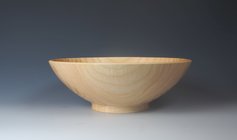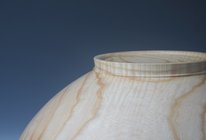Aside from utilizing a dedicated 'beading' tool, does anyone have a video clip that demonstrates how to create a bead with any of the 'traditional' tools? I've seen it done with a small bowl gouge, spindle gouge, and even a detailing gouge but never a close enough view to discern what the turner is actually doing? thanks...John
-
It's time to cast your vote in the December 2025 Turning Challenge. (click here for details) -
Congratulations to Pat White for "Sicilian Mosaic" being selected as Turning of the Week for December 29, 2025 (click here for details) -
Welcome new registering member. Your username must be your real First and Last name (for example: John Doe). "Screen names" and "handles" are not allowed and your registration will be deleted if you don't use your real name. Also, do not use all caps nor all lower case.
You are using an out of date browser. It may not display this or other websites correctly.
You should upgrade or use an alternative browser.
You should upgrade or use an alternative browser.
Beading?
- Thread starter John Grace
- Start date
Richard Raffan, using a spindle gouge:Aside from utilizing a dedicated 'beading' tool, does anyone have a video clip that demonstrates how to create a bead with any of the 'traditional' tools? I've seen it done with a small bowl gouge, spindle gouge, and even a detailing gouge but never a close enough view to discern what the turner is actually doing? thanks...John
If you’re talking about face work, the Richard Raffan method beats anything else hands down. It takes a little practice, but once you master it anything else seems foolish
john lucas
AAW Forum Expert
I learned from Richard Raffan, and the video linked above shows his technique really well. It takes some practice, like everything does, but once you get it down you'll be off to the races.
I can't imagine making a true bead with any bowl gouge. With a skew or spindle gouge you end with the flute being vertical. No way that works with a bowl gouge. Coves and beads are the groundwork for so much of what turning is in spindle work.
I do my exterior beadwork with the tip of a 1/2" 40/40-grind bowl gouge. I generally just have a single bead, though, rather than a whole series of them one next to the other. For that I'd want to use my spindle detail gouge.I can't imagine making a true bead with any bowl gouge. With a skew or spindle gouge you end with the flute being vertical. No way that works with a bowl gouge. Coves and beads are the groundwork for so much of what turning is in spindle work.
The bead between the foot and body of this narrow-leaf ash bowl is roughly 1/16" wide, cut with the 40/40 gouge.
Attachments
Last edited:
I do my exterior beadwork with the tip of a 1/2" 40/40-grind bowl gouge. I generally just have a single bead, though, rather than a whole series of them one next to the other. For that I'd want to use my spindle detail gouge.
The bead between the foot and body of this narrow-leaf ash bowl is roughly 1/16" wide, cut with the 40/40 gouge.
Kalia, that looks fantastic. This is the sort of detailing that I've struggled to learn, despite some coaching locally. Not sure I've tried with the 40/40 gouge yet though. Always another approach to the challenge. Thanks for posting.
john lucas
AAW Forum Expert
Bummer my video on turning beads is not in Youtube anymore. This is turning beads 2. Guess I'll have to redo it if I can remember what all I did. I show how to turn beads with a variety of tools and techniques. Oh well. That seems to be how my life goes.Here is my video.View: https://youtu.be/bjYehUsMdB4
Out of curiosity, what happened to your video?Bummer my video on turning beads is not in Youtube anymore.
john lucas
AAW Forum Expert
I dont know. I had a problem where I had videos on two different accounts and couldnt straighten it out. A friend came over and started a new channel and transferred all my videos to the new channel. Didnt know that one was missing. Who knows what else is missing.Out of curiosity, what happened to your video?
If you haven't yet tried grinding a gouge to 40/40, I highly recommend this video from Cindy Drozda.Kalia, that looks fantastic. This is the sort of detailing that I've struggled to learn, despite some coaching locally. Not sure I've tried with the 40/40 gouge yet though. Always another approach to the challenge. Thanks for posting.
It's the clearest explanation I've seen for how to do it accurately, and what to aim for. She also shows her similar technique for sharpening a spindle detail gouge.
Since the 40/40 grind leaves you with an 80-degree tip, you can get into some very tight spaces with it. At the end of the cut I do indeed have the flute completely closed to create that crisp edge.
And I have to ask if you're related to Peter and Mary Alice Amidon.
Thank you for sharing...the counter-clockwise motion is what I think I was missing. Time for practice.
Thank you...much appreciated.Here is my video.View: https://youtu.be/bjYehUsMdB4
Love the shape/form of that piece...quite elegant. What would you say your wall thickness is?I do my exterior beadwork with the tip of a 1/2" 40/40-grind bowl gouge. I generally just have a single bead, though, rather than a whole series of them one next to the other. For that I'd want to use my spindle detail gouge.
The bead between the foot and body of this narrow-leaf ash bowl is roughly 1/16" wide, cut with the 40/40 gouge.
I generally don't turn super thin since these are meant as functional pieces. This one is in the neighborhood of 5/16" thick, maybe a bit more.Love the shape/form of that piece...quite elegant. What would you say your wall thickness is?
That's exactly what I do...for my area, the stuff that sells best is utilitarian pieces so all of my stuff is food safe wherever possible. I find it works well for my local Farmer's Market where I sell my stuff.I generally don't turn super thin since these are meant as functional pieces. This one is in the neighborhood of 5/16" thick, maybe a bit more.
Here is my video.View: https://youtu.be/bjYehUsMdB4
That pretty much covers it all. Great video, John.
If you haven't yet tried grinding a gouge to 40/40, I highly recommend this video from Cindy Drozda.
View: https://www.youtube.com/watch?v=rhEewtRlkNA
It's the clearest explanation I've seen for how to do it accurately, and what to aim for. She also shows her similar technique for sharpening a spindle detail gouge.
Since the 40/40 grind leaves you with an 80-degree tip, you can get into some very tight spaces with it. At the end of the cut I do indeed have the flute completely closed to create that crisp edge.
And I have to ask if you're related to Peter and Mary Alice Amidon.
Hi Kalia,
I've got the 40/40 down from a sharpening and using perspective, just that I had not thought to try it for turning beads.
I do happen to have a cousin, by the name of Peter Amidon, but not a Mary Alice, so I assume we are talking about different people. Probably related distantly, however.
John's video is really good: comprehensive and compact, all the tools and techniques in 15 minutes. I watched this a while ago and the tip that really helped me was to slow down, really slow down, even stop, in the course of executing the simultaneous rotate-lift-twist movement with the spindle gouge. Trying to learn that complex movement in one quick sweep was too hard for me, but when I realized I could just stop mid-stream and say "wait, I need to be lifted more" or "twisted more" or "rotated more", I was ultimately able to get the muscle memory to do it in one sweep.Here is my video.View: https://youtu.be/bjYehUsMdB4


